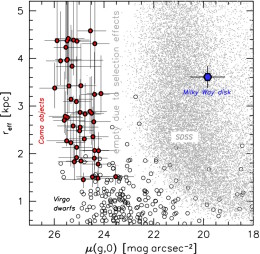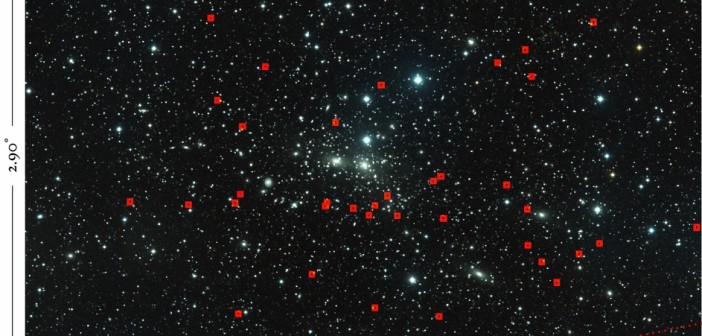Editor’s Note: In these last two weeks of 2015, we’ll be looking at a few selections from among the most-downloaded papers published in AAS journals this year. The usual posting schedule will resume after the AAS winter meeting.
Forty-Seven Milky Way-Sized, Extremely Diffuse Galaxies in the Coma Cluster
Published January 2015
Main takeaway:
Using the Dragonfly Telephoto Array, a team led by Pieter van Dokkum (Yale University) discovered 47 ultra-diffuse galaxies in the Coma galaxy cluster. These galaxies are very large, with half-light (“effective”) radii of 1.5–4.6 kpc, similar to that of the Milky Way’s disk. But their stellar masses are a factor of 1000 lower than the Milky Way’s, and they’re accordingly much dimmer.

Plot of the effective radius versus the central surface brightness for the ultra-diffuse Coma cluster galaxies (red markers). These galaxies are similar in size to the Milky Way’s disk (blue), but significantly dimmer. [Van Dokkum et al. 2015]
Why it’s interesting:
These galaxies make up an odd population. Why are their stellar masses so low? The authors posit that these objects may be failed galaxies that lost their gas after having formed their first generation of stars. Adding to the intrigue, the authors find that in order for these galaxies to hold themselves together at their current distance from the cluster core, they must have a whopping dark-matter fraction of 98%.
About the discovery:
These ultra-diffuse galaxies were actually discovered entirely by accident. Van Dokkum and collaborators observed the Coma cluster in a project to measure properties of the intra-cluster light and look for streams and tidal features. Surprisingly, their images revealed these faint, uncataloged galaxies.
Citation
Pieter G. van Dokkum et al 2015 ApJ 798 L45. doi:10.1088/2041-8205/798/2/L45

